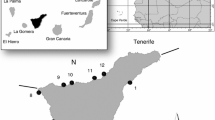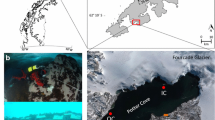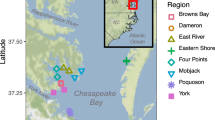Summary
The hypothesis that sea urchin grazing and interactions with turf-forming red algae prevent large brown algae from forming an extensive canopy in the low intertidal zone of southern California was tested with field experiments at two study sites. Experimental removal of sea urchins resulted in rapid algal recruitment. Crustose coralline algae which typically dominate the substratum in areas with dense urchin populations were quickly overgrown by several species of short-lived green, brown and red algae. The removal of urchins also significantly increased the recruitment of two long-lived species of large brown algae (Egregia laevigata and Cystoseira osmundacea at one study site and E. laevigata and Halidrys dioica at the other). The experimental plots at both sites were eventually dominated by perennial red algae.
A two-factorial experiment demonstrated that sea urchin grazing and preemption of space by red algae in areas where urchins are less abundant are responsible for the rarity of large brown algae in the low intertidal of southern California. The three dominant perennial red algae, Gigartina canaliculata, Laurencia pacifica and Gastroclonium coulteri, recruit seasonally from settled spores but can rapidly fill open space with vigorous vegetative growth throughout the year. These species encroach laterally into space created by the deaths of large brown algae or by other disturbances. Once extensive turfs of these red algae are established further invasion is inhibited. This interaction of algae which proliferate vegetatively with algae which recruit only from settled spores is analogous to those which occur between solitary and colonial marine invertebrates and between solitary and cloning terrestrial plants.
It is suggested that a north-south gradient in the abundance of vegetatively propagating species, in grazing intensity and in the frequency of space-clearing disturbances, may account for latitudinal variation in intertidal algal community structure along the Pacific coast of North America.
Similar content being viewed by others
References
Abbott IA, Holleberg GJ (1976) Marine algae of California. Stanford Univ Press, Stanford
Abbott IA, North WJ (1972) Temperature influences on floral composition in California coastal waters. Proc Int Seaweed Symp 7:72–79
Bernstein BB, Jung N (1979) Selective pressures and coevolution in a kelp canopy community in southern California. Ecol Monogr 48:335–355
Black R (1974) Some biological interactions affecting intertidal populations of the kelp Egregia laevigata. Mar Biol 28:189–198
Black R (1976) The effects of grazing by the limpet, Acmaea insessa, on the kelp, Egregia laevigata, in the intertidal zone. Ecology 57:265–277
Brawley SH, Adey WH (1980) The effects of micrograzers on algal community structure in a coral reef microcosm. Mar Biol (in press)
Chapman VJ (1943) Zonation of marine algae on the seashore. Proc Linnean Soc London 154:239–253
Connell JH (1972) Community interactions on marine rocky intertidal shores. Ann Rev Ecol Syst 3:169–192
Connell JH (1974) Ecology: field experiments in marine ecology. In: Mariscal RN (ed) Experimental marine biology. Academic Press, New York, p 21–54
Connell JH (1975) Some mechanisms producing structure in natural communities: a model and evidence from field experiments. In: Cody ML, Diamond JM (eds) Ecology and evolution of communities. Harvard Univ Press, Cambridge, p 460–490
Connell JH, Orias E (1964) The ecological regulation of species diversity. Am Nat 98:399–414
Connor JL, Adey WH (1977) The benthic algal composition, standing crop, and productivity of a Caribbean algal ridge. Atoll Res Bull 211:1–40
Dahl AL (1972) Ecology and community structure of some tropical reef algae in Samoa. Proc Int Seaweed Symp 7:36–39
Dayton PK (1971) Competition, disturbance, and community organization: the provision and subsequent utilization of space in a rocky intertidal community. Ecol Monogr 41:351–389
Dayton PK (1973) Dispersion, dispersal, and persistence of the annual intertidal alga, Postelsia palmaeformis Ruprecht. Ecology 54:433–438
Dayton PK (1973a) Two cases of resource partitioning in an intertidal community: making the right prediction for the wrong reason. Am Nat 107:662–670
Dayton PK (1975) Experimental evaluation of ecological dominance in a rocky intertidal algal community. Ecol Monogr 45:137–159
Dixon PS (1965) Perennation, vegetative propagation and algal life histories, with special reference to Asparagopsis and other Rhodophyta. Bot Gotheburg III Proc Vth Mar Biol Symp Goteborg, 67–74
Dobzhansky T (1950) Evolution in the tropics. Amer Sci 38:209–221
Ebert TA (1977) An experimental analysis of sea urchin dynamics and community interactions on a rock jetty. J exp mar Biol Ecol 27:1–22
Emerson SE, Zedler JB (1978) Recolonization of intertidal algae: an experimental study. Mar Biol 44:315–324
Foster MS (1972) The algal turf community in the nest of the ocean goldfish, Hypsypops rubicunda. Proc Int Seaweed Symp 7:55–60
Francis L (1979) Contrast between solitary and clonal lifestyles in the sea anemone, Anthopleura elegantissima. Am Zool 19:671–683
Garbary D (1976) Life-forms of algae and their distribution. Bot Mar 19:97–106
Gonor JF (1973) Reproductive cycles in Oregon populations of the echinoid, Strongylocentrotus purpuratus (Stimpson). I. Annual gonad growth and ovarian gametogenic cycles. J exp mar Biol Ecol 12:45–64
Hay ME (1978) The adaptive significance of the turf growth form: an enumeration of the costs and benefits of coloniality in marine macroalgae. J Phycol 14 (suppl), 28 (abstract)
Hay ME (1980) Algal ecology on a Caribbean fringing reef. Ph D Thesis Univ California, Irvine
Harper JL (1977) Population biology of plants. Academic Press, London
Himmelman JH, Carefoot TH (1975) Seasonal changes in calorific value of three Pacific coast seaweeds, and their significance to some marine invertebrate herbivores. J exp mar Biol Ecol 18:139–151
Hoek C van den (1975) Phytogeographic provinces along the coasts of the northern Atlantic Ocean. Phycologia 14:317–330
Hutchinson GE (1951) Copepodology for the ornithologist. Ecology 32:571–577
Inger RF, Colwell RK (1977) Organization of contiguous communities of amphibians and reptiles in Thailand. Ecol Monogr 47:229–253
Jackson JBC (1977) Competition on marine hard substrata: the adaptive significance of solitary and colonial strategies. Am Nat 111:743–767
John DM, Pople W (1973) The fish grazing of rocky shore algae in the Gulf of Guinea. J exp mar Biol Ecol 11:81–90
Karlson R (1978) Predation and space utilization patterns in a marine epifaunal community. J exp mar Biol Ecol 31:225–239
Lawrence J (1975) On the relationships between marine plants and sea urchins. Ann Rev Oceanogr Mar Biol 13:213–286
Lewis JR (1964) The ecology of rocky shores. English Univ Press, London
Littler MM, Littler DS (1980) The evolution of thallus form and survival strategies in benthic marine macroalgae: field and laboratory tests of a functional form model. Am Nat 116:25–44
Lubohenco J (1980) Algal zonation in the New England rocky intertidal community: an experimental analysis. Ecology 61:333–344
MacArthur RH (1965) Patterns of species diversity. Biol Rev 40:510–533
MacArthur RH (1972) Geographical ecology. Harper and Row, New York
Menge BA, Sutherland JP (1976) Species diversity gradients: synthesis of the roles of predation, competition, and temporal heterogeneity. Am Nat 110:351–369
Murray SN, Littler MM (1978) Patterns of algal succession in a perturbated marine intertidal community. J Phycol 14:506–512
Neushul M, Dahl AL (1967) Composition and growth of subtidal parvosilvosa from Californian kelp forests. Helgoländer wiss Meeresunters 15:480–488
Nicotri ME (1980) Factors involved in herbivore food preference. J exp mar Biol Ecol 42:13–26
Niering WA, Egler FE (1955) A shrub community of Viburnum lentago, stable for twenty-five years. Ecology 36:356–360
Niering WA, Goodwin RH (1974) Creation of relatively stable shrublands with herbicides: arresting “succession” on rights-of-way and pastureland. Ecology 55:784–795
Osman RW (1977) The establishment and development of a marine epifaunal community. Ecol Monogr 47:37–63
Paine RT (1966) Food web complexity and species diversity. Am Nat 100:65–75
Paine RT (1971) A short-term experimental investigation of resource partitioning in a New Zealand rocky intertidal habitat. Ecology 52:1096–1106
Paine RT (1974) Intertidal community structure: experimental studies on the relationship between a dominant competitor and its principal predator. Oecologia (Berl) 15:93–120
Paine RT (1977) Controlled manipulations in the marine intertidal zone, and their contributions to ecological theory. In: The changing scenes in natural sciences, 1776–1976. Acad Natural Sci Special publ 12:245–270
Paine RT (1979) Disaster, catastrophe, and local persistence of the sea palm Postelsia palmaeformis. Science 205:685–687
Paine RT, Vadas RL (1969) The effects of grazing by sea urchins, Strongylocentrotus spp., on benthic algal populations. Limnol Oceanogr 14:710–719
Pianka ER (1966) Latitudinal gradients in species diversity: a review of concepts. Am Nat 100:33–46
Pianka ER (1975) Niche relations of desert lizards. In: Cody ML, Diamond JM (eds) Ecology and evolution of communities. Harvard Univ Press, Cambridge, p 292–314
Ricketts EF, Calvin J (1968) Between Pacific tides, Fourth edition, revised by J W Hedgpeth. Stanford Univ Press, Stanford
Salisbury EJ (1942) The reproductive capacity of plants. G Bell, London
Schonbeck MW, Norton TA (1978) Factors controlling the upper limits of fucoid algae on the shore. J exp mar Biol Ecol 31:303–313
Sebens KP (1977) Habitat suitability, reproductive ecology and the plasticity of body size in two sea anemone populations. Ph D Thesis Univ Washington, Seattle
Snedecor GW, Cochran WG (1967) Statistical methods, Sixth edition. Iowa State Univ Press, Ames
Sousa WP (1979) Experimental investigations of disturbance and ecological succession in a rocky intertidal algal community. Ecol Monogr 49:227–254
Sousa WP (1979a) Disturbance in marine intertidal boulder fields: the non-equilibrium maintenance of species diversity. Ecology 60:1225–1239
Sousa WP (1980) The responses of a community to disturbance: the importance of successional age and species' life histories. Oecologia (Berl) 45:72–81
Stebbins ARD (1973) Competition for space between the epiphytes of Fucus serratus L. J Mar Biol Ass UK 53:247–261
Stephenson TA (1943) The causes of the vertical and horizontal distribution of organisms between tidemarks in South Africa. Proc Linnean Soc London 154:219–232
Stephenson TA, Stephenson A (1972) Life between tidemarks on rocky shores. WH Freeman and Co, San Francisco
Stewart JG (1968) Morphological variation in Pterocladia pyramidale. J Phycol 4:76–84
Sutherland JP (1973) Multiple stable points in natural communities. Am Nat 108:859–873
Sutherland JP (1978) Functional roles of Schizoporella and Styela in the fouling community at Beaufort, North Carolina. Ecology 59:257–264
Sutherland JP, Karlson RH (1977) Development and stability of the fouling community at Beaufort, North Carolina. Ecol Monogr 47:425–446
Tarp CL (1979) The natural history of some epiphytic hydroids and bryozoans. Ph D Thesis Univ California, Berkeley
Thom RM (1980) A gradient in benthic intertidal algal assemblages along the southern California coast. J Phycol 16:102–108
Thom RM, Widdowson TB (1978) A resurvey of E. Yale Dewson's 42 intertidal transects on the southern California mainland after 15 years. Bull South Calif Acad Sci 77:1–13
Vadas RL (1977) Preferential feeding: an optimization strategy in sea urchins. Ecol Mongr 47:337–371
Widdowson TB (1965) A survey of the distribution of intertidal algae along a coast transitional in respect to salinity and tidal factors. J Fish Res Board Can 22:1425–1454
Woodin SA (1976) Adult-larval interactions in dense infaunal assemblages: patterns of abundance. J Mar Res 34:25–41
Woodin SA, Jackson JBC (1979) Interphyletic competition among marine benthos. Am Zool 19:1029–1043
Young DN (1971) Autecology of Postelsia palmaeformis in San Luis Obispo County, California. Masters Thesis, California State Polytechnic College, San Luis Obispo
Author information
Authors and Affiliations
Rights and permissions
About this article
Cite this article
Sousa, W.P., Schroeter, S.C. & Gaines, S.D. Latitudinal variation in intertidal algal community structure: the influence of grazing and vegetative propagation. Oecologia 48, 297–307 (1981). https://doi.org/10.1007/BF00346486
Received:
Issue Date:
DOI: https://doi.org/10.1007/BF00346486




